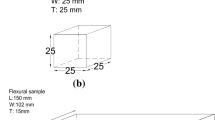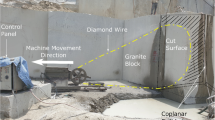Abstract
In this study, a new predictor parameter (NPP), which is based on the product of uniaxial compressive strength (UCS) and Mohs hardness (MH), was proposed for prediction of production rate (PR) of ornamental stones. For this, the PR, MH and UCS of ten different igneous stones were determined, and then their NPP was calculated. Using data analysis, a statistical equation has been developed between PR and NPP using simple regression analysis. The validity of NPP for prediction of PR was investigated using the raw data obtained from experimental works of two researchers. It was concluded that the NPP has good accuracy for prediction of PR, and thus making a rapid PR assessment of stones. As a result, the NPP proposed in this study provides significant practical advantages in predicting the cost and production schedule.













Similar content being viewed by others
References
Almasi SN, Bagherpour R, Mikaeil R, Ozcelik Y, Kalhori H (2017a) Predicting the building stone cutting rate based on rock properties and device pullback amperage in quarries using M5P model tree. Geotech Geol Eng 35:1311–1326
Almasi SN, Bagherpour R, Mikaeil R, Ozcelik Y (2017b) Analysis of bead wear in diamond wire sawing considering the rock properties and production rate. Bull Eng Geol Environ. https://doi.org/10.1007/s10064-017-1057-9
Armaghani DJ, Mohamad ET, Hajihassani M, Yagiz S, Motaghedi H (2016) Application of several non-linear prediction tools for estimating uniaxial compressive strength of granitic rocks and comparison of their performances. Eng Comput 32:189–206
Ataei M, Mikaiel R, Sereshki F, Ghaysari N (2012) Predicting the production rate of diamond wire saw using statistical analysis. Arab J Geosci 5:1289–1295
Atici U, Ersoy A (2009) Correlation of specific energy of cutting saws and drilling bits with rock brittleness and destruction energy. J Mater Process Technol 209:2602–2612
Aydin G, Karakurt I, Hamzacebi C (2015) Performance prediction of diamond sawblades using artificial neural network and regression analysis. Arab J Sci Eng 40:2003–2012
Bagherpour R, Khademian A, Almasi SN, Aalaei M (2014) Optimum cutting wire assembly situation in dimension stone quarries. J Min Metall Metall 50:1–8
Beiki M, Majdi A, Givshad AD (2013) Application of genetic programming to predict the uniaxial compressive strength and elastic modulus of carbonate rocks. Int J Rock Mech Min Sci 63:159–169
Bianconi F, Gonzalez E, Fernandez A, Saetta SA (2012) Automatic classification of granite tiles through colour and texture features. Expert Sys App 39:11212–11218
Burgess RB (1978) Circular sawing granite with diamond saw blades. In: Proceedings of the fifth industrial diamond seminar, 3–10
Buyuksagis IS (2007) Effect of cutting mode on the sawability of granites using segmented circular diamond sawblade. J Mater Process Technol 183:399–406
Ceryan N (2014) Application of support vector machines and relevance vector machines in predicting uniaxial compressive strength of volcanic rocks. J Afr Earth Sci 100:634–644
Chatterjee TK, Chatterjee R, Singh S (2005) Classification of black decorative stones from Warangal District, Andhra Pradesh, India. Bull Eng Geol Environ 64:167–173
Clausen R, Wang CY, Meding M (1996) Characteristics of acoustic emission during single diamond scratching of granite. Ind Diam Rev 3:96–99
Delgado NS, Rodriguez R, Rio A, Sarria ID, Calleja L, Argandona VGR (2005) The influence of microhardness on the sawability of pink Porrino granite (Spain). Int J Rock Mech Min Sci 42:161–166
Ersoy A, Atici U (2004) Performance characteristics of circular diamond saws in cutting different types of rocks. Diam Relat Mater 13:22–37
Ersoy A, Buyuksagis IS, Atici U (2005) Wear characteristics of circular diamond saws in the cutting of different hard and abrasive rocks. Wear 258:1422–1436
Eyuboglu AS, Ozcelik Y, Kulaksiz S, Engin IC (2003) Statistical and microscopic investigation of disc segment wear related to sawing Ankara andesites. Int J Rock Mech Min Sci 40:405–414
Fener M, Kahraman S, Ozder MO (2007) Performance prediction of circular diamond saws from mechanical rock properties in cutting carbonate rocks. Rock Mech Rock Eng 40(5):505–517
Ghaysari N, Ataei M, Sereshki F, Mikaiel R (2012) Prediction of performance of diamond wire saw with respect to texture characteristics of rock. Arch of Min Sci 57(4):887–900
Gunaydin O, Kahraman S, Fener M (2004) Sawability prediction of carbonate rocks from brittleness indexes. J South Afr Inst Min Metall 104:239–244
Guney A (2011) Performance prediction of large-diameter circular saws based on surface hardness tests for Mugla (Turkey) marbles. Rock Mech Rock Eng 44:357–366
ISRM (1981) Rock characterization testing and monitoring. ISRM suggested methods. In: Brown ET (ed)
ISRM (2007) The complete ISRM suggested methods for rock characterization, testing and monitoring. In: Ulusay R, Hudson JA (eds.), Suggested methods prepared by the commission on testing methods (1974–2006)
Jamshidi A, Nikudel MR, Khamehchiyan M (2017) A novel physico-mechanical parameter for estimating the mechanical strength of travertines after a freeze-thaw test. Bull Eng Geol Environ 76(1):181–190
Jennings M, Wright DN (1989) Guidelines for sawing stone. Ind Diam Rev 49:70–75
Kahraman S, Fener M, Gunaydin O (2004) Predicting the sawability of carbonate rocks using multiple curvilinear regression analysis. Int J Rock Mech Min Sci 41(7):1123–1131
Kahraman S, Altunb H, Tezekicib BS, Fener M (2006) Sawability prediction of carbonate rocks from shear strength parameters using artificial neural networks. Int J Rock Mech Min Sci 43:157–164
Kainthola A, Singh P, Verma D, Singh R, Sarkar K, Singh T (2015) Prediction of strength parameters of Himalayan rocks: a statistical and ANFIS approach. Geotech Geol Eng 33:1255–1278
Madhubabu N, Singh P, Kainthola A, Mahanta B, Tripathy A, Singh T (2016) Prediction of compressive strength and elastic modulus of carbonate rocks. Meas 88:202–213
Mikaeil R, Ataei M, Hoseinie SH (2008) Predicting the production rate of diamond wire saws in carbonate rock cutting. Ind Diam Rev 3:28–34
Mikaeil R, Ataei M, Yousefi R (2013a) Correlation of production rate of ornamental stone with rock brittleness indexes. Arab J Geosci 6(1):115–121
Mikaeil R, Ozcelik Y, Yousefi R, Ataei M, Hosseini SM (2013b) Ranking the sawability of ornamental stone using fuzzy Delphi and multi-criteria decision-making techniques. Int. J. Rock Mech Min Sci 58:118–126
Mishra D, Basu A (2013) Estimation of uniaxial compressive strength of rock materials by index tests using regression analysis and fuzzy inference system. Eng Geol 160:54–68
Mohamad ET, Armaghani DJ, Momeni E, Abad SVANK (2015) Prediction of the unconfined compressive strength of soft rocks: a PSO-based ANN approach. Bull Eng Geol Environ 74:745–757
Monjezi M, Khoshalan HA, Razifard M (2012) A neuro-genetic network for predicting uniaxial compressive strength of rocks. Geotech Geol Eng 30:1053–1062
Norling RG (1971) Mechanical properties and the composition of some Swedish natural stone types and their effect on cutting results. Presentation at the Conference on Diamond in the Construction and Stone Industry (In German)
Ozcelik Y (2005) Effect of mineralogical and petrographical properties of marble on cutting by diamond wire. CIM Bull 98(1085):1–6
Ozcelik Y (2007) The effect of marble textural characteristics on the sawing efficiency of diamond segmented frame saws. Ind Diam Rev 2:65–70
Ozcelik Y, Polat E, Bayram F, Ay AM (2004) Investigation of the effects of textural properties on marble cutting with diamond wire. Int J Rock Mech Min Sci 41(3):228–234
Sadegheslam G, Mikaeil R, Rooki R, Ghadernejad S, Ataei M (2013) Predicting the production rate of diamond wire saws using multiple nonlinear regression analysis. Geos Eng 16:275–285
Singh P, Tripathy A, Kainthola A, Mahanta B, Singh V, Singh T (2017) Indirect estimation of compressive and shear strength from simple index tests. Eng Comput 33:1–11
Tumac D (2015) Predicting the performance of large diameter circular saws based on Schmidt hammer and other properties for some Turkish carbonate rocks. Int J Rock Mech Min Sci 75:159–168
Tumac D (2016) Artificial neural network application to predict the sawability performance of large diameter circular saws. Meas 80:12–20
Wright DN, Cassapi VB (1985) Factors influencing stone sawability. Ind Diam Rev 2:84–87
Yurdakul M, Gopalakrishnan K, Akdas H (2014) Prediction of specific cutting energy in natural stone cutting processes using the neuro-fuzzy methodology. Int J Rock Mech Min Sci 67:127–135
Author information
Authors and Affiliations
Corresponding author
Rights and permissions
About this article
Cite this article
Jamshidi, A. A new predictor parameter for production rate of ornamental stones. Bull Eng Geol Environ 78, 2565–2574 (2019). https://doi.org/10.1007/s10064-018-1263-0
Received:
Accepted:
Published:
Issue Date:
DOI: https://doi.org/10.1007/s10064-018-1263-0




